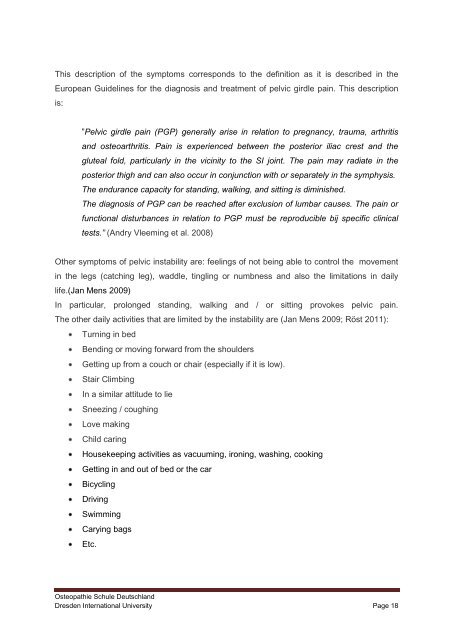Pelvic girdle pain and relevance of ASLR testing: A ... - Cindy Verheul
Pelvic girdle pain and relevance of ASLR testing: A ... - Cindy Verheul
Pelvic girdle pain and relevance of ASLR testing: A ... - Cindy Verheul
Create successful ePaper yourself
Turn your PDF publications into a flip-book with our unique Google optimized e-Paper software.
This description <strong>of</strong> the symptoms corresponds to the definition as it is described in the<br />
European Guidelines for the diagnosis <strong>and</strong> treatment <strong>of</strong> pelvic <strong>girdle</strong> <strong>pain</strong>. This description<br />
is:<br />
”<strong>Pelvic</strong> <strong>girdle</strong> <strong>pain</strong> (PGP) generally arise in relation to pregnancy, trauma, arthritis<br />
<strong>and</strong> osteoarthritis. Pain is experienced between the posterior iliac crest <strong>and</strong> the<br />
gluteal fold, particularly in the vicinity to the SI joint. The <strong>pain</strong> may radiate in the<br />
posterior thigh <strong>and</strong> can also occur in conjunction with or separately in the symphysis.<br />
The endurance capacity for st<strong>and</strong>ing, walking, <strong>and</strong> sitting is diminished.<br />
The diagnosis <strong>of</strong> PGP can be reached after exclusion <strong>of</strong> lumbar causes. The <strong>pain</strong> or<br />
functional disturbances in relation to PGP must be reproducible bij specific clinical<br />
tests.” (Andry Vleeming et al. 2008)<br />
Other symptoms <strong>of</strong> pelvic instability are: feelings <strong>of</strong> not being able to control the movement<br />
in the legs (catching leg), waddle, tingling or numbness <strong>and</strong> also the limitations in daily<br />
life.(Jan Mens 2009)<br />
In particular, prolonged st<strong>and</strong>ing, walking <strong>and</strong> / or sitting provokes pelvic <strong>pain</strong>.<br />
The other daily activities that are limited by the instability are (Jan Mens 2009; Röst 2011):<br />
Turning in bed<br />
Bending or moving forward from the shoulders<br />
Getting up from a couch or chair (especially if it is low).<br />
Stair Climbing<br />
In a similar attitude to lie<br />
Sneezing / coughing<br />
Love making<br />
Child caring<br />
Housekeeping activities as vacuuming, ironing, washing, cooking<br />
Getting in <strong>and</strong> out <strong>of</strong> bed or the car<br />
Bicycling<br />
Driving<br />
Swimming<br />
Carying bags<br />
Etc.<br />
Osteopathie Schule Deutschl<strong>and</strong><br />
Dresden International University Page 18


